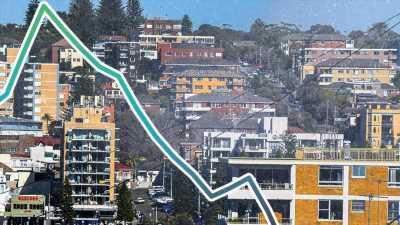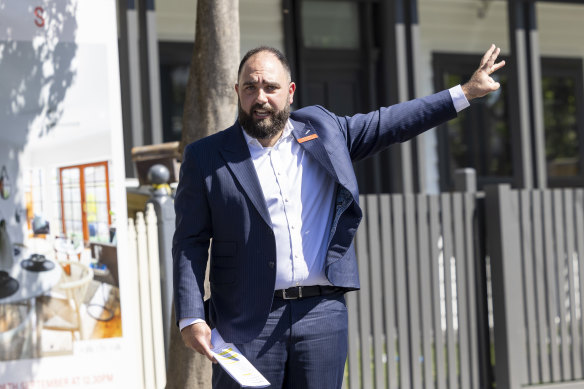Save articles for later
Add articles to your saved list and come back to them any time.
Key points
- The withdrawal of first home buyer incentives contributed to a drop in activity over 2008 to 2010 and again in 2020 to 2022.
- First home buyers now face higher interest rates and rising property prices.
- Remaining first home buyers in the market would typically be those with generational wealth and high salaries, experts said.
Property listings
The most recent property boom caused one of the steepest falls in first home buyer activity in 20 years, indicating a sharp decrease in affordability as prices spiked.
The amount of new loans granted to first home buyers declined sharply during the October 2020 to April 2022 property boom, CoreLogic analysis of ABS data showed, from a peak of more than 16,000 a month to below 10,000.
The sharp drop was comparable to the post-GFC boom between February 2008 and June 2010, but was a contrast to the extended 2012 to 2017 bull run when first home buyer activity was steadier at low levels, often below 8000 loans a month.
A common theme between both price explosions and subsequent first home buyer retreats was the removal of incentives designed to help first-home buyers get a leg-up into the market, CoreLogic head of Australian research Eliza Owen said, of the ANZ/CoreLogic Housing Affordability report, released this week.
“It varies a little bit because there’s been different schemes and things introduced in the periods of upswing, but last cycle shows a pretty quick drop off of first home buyer activity after the expiry of HomeBuilder [grant] and the rapid nature of home value uplift has contributed to that as well,” she said.
“[The data] shows when the market starts to pick up, first home buyers can’t keep up with the pace of increase and the deposit hurdle becomes more pronounced.”
Since then, interest rates jumped which sparked a steep property downturn last year. Property prices began to recover this year as buyers fought for the few homes for sale.
The Reserve Bank has held interest rates steady for the last three months, although minutes released on Tuesday showed it considered another hike in its September meeting.
Westpac senior economist Matthew Hassan agreed the end of HomeBuilder had caused the swift decline in first home buyer activity, in concert with spiking prices.
“[In 2008 to 2010], again there was a first home buyer scheme rolling out during the [boom] as well,” he said.
First home buyers would be struggling in the rising market, experts say, despite a recent lack of ABS data on the subject. Credit: Wayne Taylor
“Both of those schemes were temporary, so they led to a big pull forward of demand.”
Owen said the 2012 to 2017 boom had a low level of, and steady decline in, first home buyer activity when compared to the most recent upswing. This showed that the market drivers significantly affected first-home affordability.
“[First home buyer activity] does become more subdued as time goes on, and it only really starts to ramp up as the growth of home values starts to slow, and the market reaches a turning point,” she said.
“Which might seem counterintuitive because property prices would be pretty high at that point. But 2017 was when we saw a limit on investor activity in the market. It could be that toward the end of the upswing the introduction of those macroprudential policies gave first home buyers a bit more space.”
The ABS dataset of first home buyer loans has been paused, so it was hard to gauge the response to recent price hikes, Hassan said.
“I think we’d be seeing weakening activity,” he said. “Particularly since the start of the year with prices starting to rise.
“First home buyers are the most marginal buyers. It’s almost certainly become more difficult in the past six months.”
Owen said there were still some first home buyers entering the market, but were more likely to be the beneficiaries of intergenerational wealth and high salaries.
“This is now a double whammy of a high deposit hurdle and high interest costs,” she said. “It would be exacerbating inequality.
“The first home buyer who is getting into the market now is probably someone who is getting assistance with a deposit, and they would be able to get a loan and service it with a high interest cost. Having a lot of wealth helps and having a high income helps.”
Owen said the new shared equity scheme offered by the federal government would make it easier for some buyers who would otherwise struggle to buy in the high-rates-and prices environment.
Cate Bakos Property owner/manager Cate Bakos said first home buyers were buoyed by government shared equity programs. Victoria already offers one such program and a federal version is set to start next year.
“Brokers are skilled up with all the initiatives that are available out there to help them,” she said. “They’re getting a few free kicks without having to pay lender’s mortgage insurance with a 5 per cent deposit.
“A lot of investors have been selling, and investors typically are owning and selling first home buyer properties rather than family homes.”
The Morning Edition newsletter is our guide to the day’s most important and interesting stories, analysis and insights. Sign up here.
Most Viewed in Property
Source: Read Full Article



